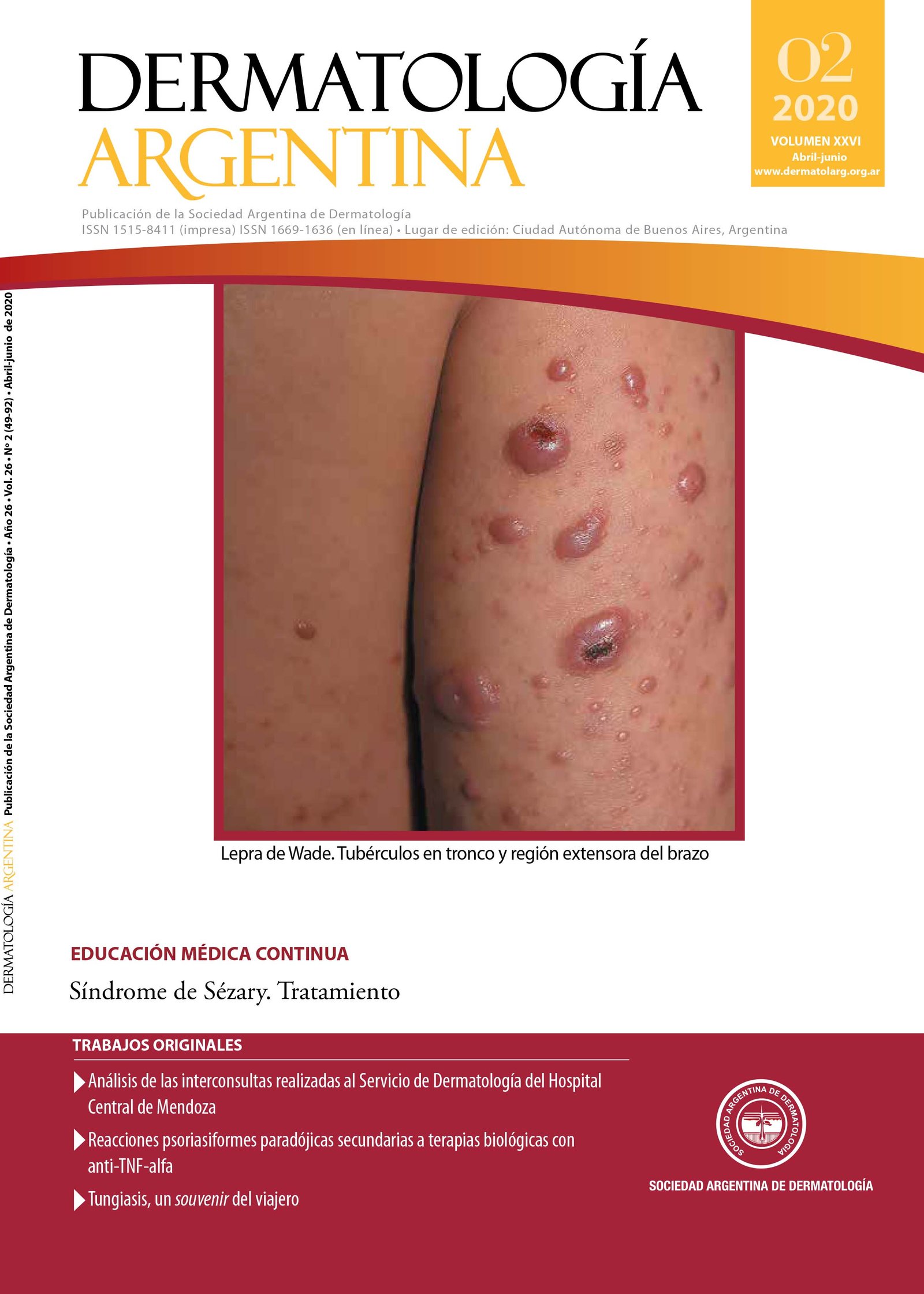Analysis of the medical consultations performed at the Hospital Central de Mendoza’s Dermatology Service
DOI:
https://doi.org/10.47196/da.v26i2.2075Keywords:
Medical consultations, Hospitalized patients, Outpatients, DermatologyAbstract
Background: Dermatology has classically been considered a medical specialty confined to the ambulatory scope. Nevertheless, patients admitted frequently present skin conditions that can be associated or not to a systemic disease.
Objective: To analyze the medical consultation performed at the Hospital Central de Mendoza’s Dermatology Service.
Design: Observational, analytical, longitudinal section study.
Materials and methods: in this study were included 425 medical consultations from hospitalized and ambulatory patients, that required urgent dermatological examination, from the 1st of February to the 31st of August, 2019.
Results: 266 (62.59%) medical consultations from ambulatory patients requiring urgent dermatological examination were analyzed, and from them, 228 (85.71%) were referred from the medical on-call service. 159 (37.41%) consisted in hospitalized patients’ consultations, from which 74 (46.54%) were requested by the Internal Medicine Service. The infectious skin diseases were the most frequent (38.82%), followed by the inflammatory skin diseases (37.65%). Skin lesions associated with systemic diseases were more frequent in the inpatients (p = 0,003). From the total of medical consultations, 230 (54.11%) had a presumptive diagnosis, where 127 (55.21%) of the cases matched the definitive diagnosis. Although clinicians made more accurate presumptive diagnoses than surgeons (30.95% vs. 23.40%, respectively), there was no statistically significant difference between them (p = 0.28).
Conclusion: Dermatological examination facilitates the diagnosis and patient’s management in the hospital context.
References
I. Lorente-Lavirgen AI, Bernabeu-Wittel J, Pulpillo-Ruiz A, De la Torre-García JM, et ál. Interconsulta hospitalaria en Dermatología sobre una cohorte prospectiva en un hospital español de tercer nivel. Actas Dermosifiliogr 2013;104:148-155.
II. Storan E, McEvoy M, Wetter, El-Azhary R, et ál. Experience of a year of adult hospital dermatology consultations. Int J Dermatol 2015;54:1150-1156.
III. Galimberti F, Guren L, Fernandez AP, Sood A. Dermatology consultations significantly contribute quality to care of hospitalized patients: a prospective study of dermatology inpatient consults at a tertiary care center. Int J Dermatol 2016;76:169-173.
IV. Cavero-Guardamino JA. Características demográficas y clínicas de los pacientes evaluados en interconsulta dermatológica en un hospital nacional de Lima-Perú. Análisis de un quinquenio. Dermatol Perú 2017;27:74-78.
V. Pereira AR, Porro AM, Seque CA, Pasin VP, et ál. Interconsulta hospitalaria en dermatología en una unidad de transplante renal. Actas Dermosifiliogr 2018;109:900-907.
VI. Falanga V, Schachner LA, Rae V, Ceballos PI, et ál. Dermatologic Consultations in the Hospital Setting. Arch Dermatol 1994;130:1022-1025.
VII. Peñate Y, Guillermo N, Melwani P, Martel R, et ál. Dermatologists in Hospital Wards: An 8-Year Study of Dermatology Consultations. Dermatology 2009;219:225-231.
VIII. Mancusi S, Festa Neto C. Inpatient dermatological consultations in a university hospital. Clinics 2010;65:851-855.
IX. Stanley C, Rubinstein A, Kaler M, Burgos M. Situación y respuesta a las infecciones de transmisión sexual. Boletín epidemiológico sobre el VIH, SIDA e ITS en la Argentina 2018;35:12-18.
X. Özyurt S, Kelekçi K, Şeremet S, Özçelik S. Analysis of Inpatient Dermatologic Consultations. Actas Dermosifiliogr 2014;105:799-800.
XI. Tay LK, Lee HY, Thirumoorthy T, Pang SM. Dermatology referrals in an East Asian tertiary hospital: a need for inpatient medical Dermatology. Clin Exp Dermatol 2010;36:129-134.
XII. H- Bauer J, Maroon M. Dermatology inpatient consultations: A retrospective study. J Am Acad Dermatol 2010;62:518-519.
XIII. Fuentes-Suárez A, Domínguez-Soto L. Menosprecio hacia la Dermatología y su repercusión. Rev Med Inst Mex Seguro Soc 2015;53:250-253.
XIV. Afsar F. Analysis of pediatric dermatology inpatient consultations in a pediatric teaching hospital. Arch Argent Pediatr 2017;115:377-384.
XV. Biesbroeck K, Shinohara M. Inpatient consultative dermatology. Med Clin North Am 2015;99:1349-1364.
Downloads
Published
Issue
Section
License
El/los autor/es tranfieren todos los derechos de autor del manuscrito arriba mencionado a Dermatología Argentina en el caso de que el trabajo sea publicado. El/los autor/es declaran que el artículo es original, que no infringe ningún derecho de propiedad intelectual u otros derechos de terceros, que no se encuentra bajo consideración de otra revista y que no ha sido previamente publicado.
Le solicitamos haga click aquí para imprimir, firmar y enviar por correo postal la transferencia de los derechos de autor














